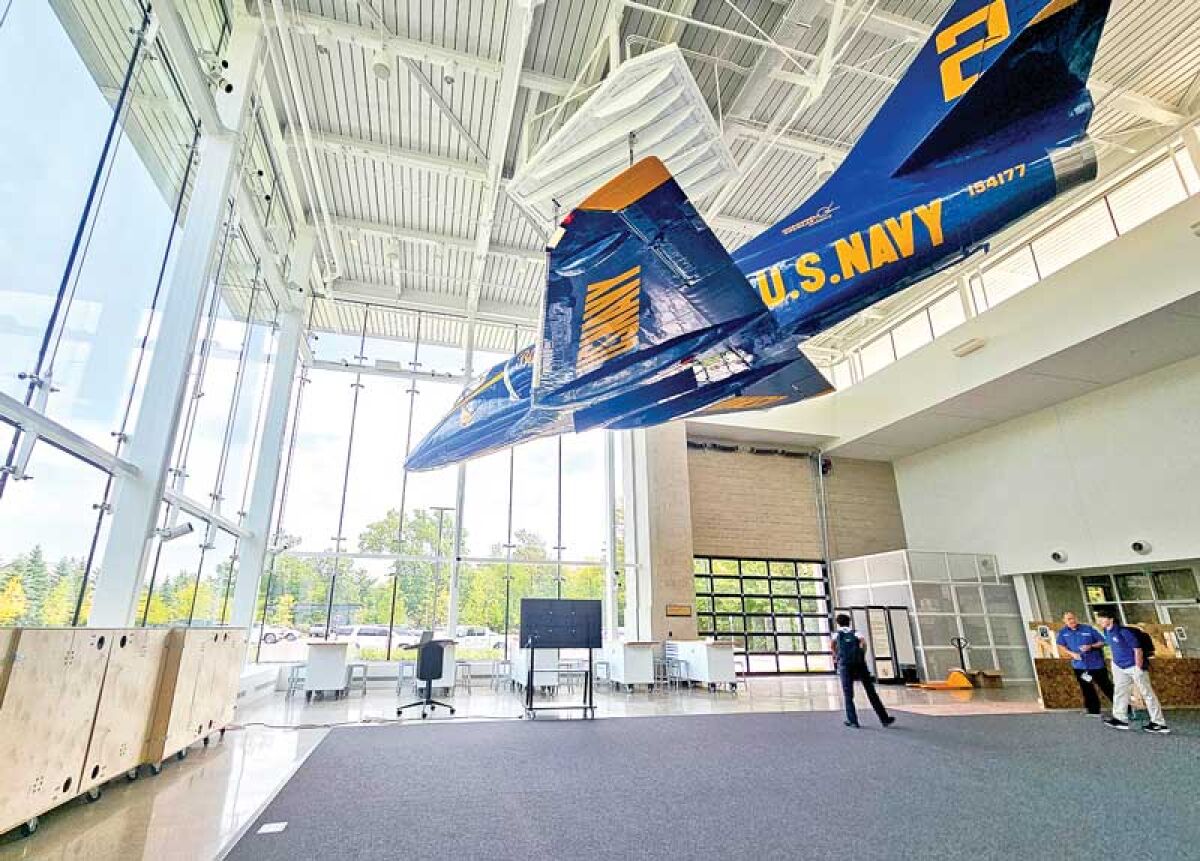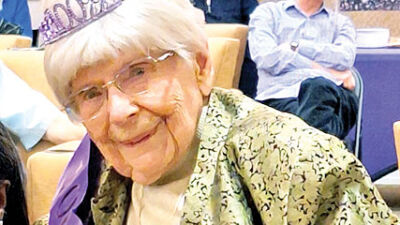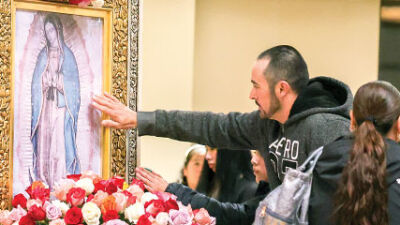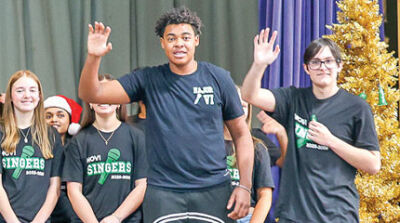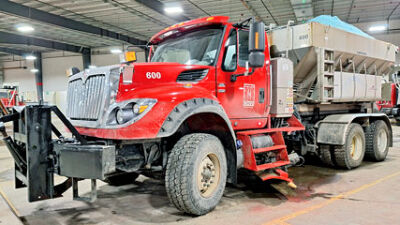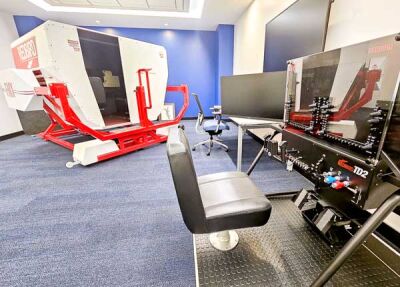
Students at Catholic Central High School are able to utilize these Redbird FMX and TD2 flight simulators during aviation classes to train to become pilots.
Photo by Patricia O’Blenes
NOVI — Detroit Catholic Central High School, in Novi, which is marketed as the largest private school in the state, just got a bit larger with the opening of a new state-of-the-art science, technology, engineering and math center Aug. 11.
Known as the George and Mary Turek Hall of Science, the $61 million expansion has 57,000 square feet of learning space and is designed to last 100 years.
“Sometimes schools are struggling to make the building, the facilities, the equipment work for what they want to do. We’ve been put in more of a unique situation where the donors wanted the building, and the resources going into the building, to challenge us to fill it with curriculum,” said Jake Marmul, Catholic Central director of admissions and public relations.
The building features an aviation suite; a fabrication and machinery shop; a sustainably focused greenhouse; a FIRST Robotics competition field, along with robotics programming and building spaces; a 4-meter Observa-Dome with a GPS computerized Celestron telescope; an innovation space; an Engineering/CAD Lab; eight dedicated science laboratories, which are 2.5 times larger than a normal classroom; 4 lab prep rooms; and upon completion of construction, an immersion theater where students can feel like they are part of the film they are viewing.
The Hall of Science is named after the parents of George Turek, an alumnus from the Class of 1966 and the primary donor for the project. The STEM wing is designed as a U-shaped offshoot of the school’s main hallway with inspiration from many colleges, most notably the Jordan Hall of Science at the University of Notre Dame.
“When they designed the building, they wanted to maintain an easy flow for our kids,” Marmul said “So, when they were looking at how to add a STEM wing, they just did another little loop. … So for the kids’ perspective for navigating where they’re going, it just makes it very easy because everything is in one section. They are not trying to figure out wings or anything like that. If you can do Pac-Man and turn left when you hit a wall, you’ll be OK.”
Biology instructor Jeff Baker said that he is overwhelmed with the vast amount of equipment he now has at his disposal to instruct his students on things such as polymerase chain reaction. The $5,000 PCR machines are used to amplify and study billions of copies of DNA.
“The potential is amazing,” Baker said. “We got all the toys. That’s going to be so cool. I can’t wait to do PCR.”
According to Amy Ely, the school’s director of STEM, Catholic Central is the only private school in southeast Michigan to offer a flight training program, through which students can obtain their pilot’s licenses. The school has multiple flight simulators for students to train on and acquire flight hours necessary for their licenses. The school has a Redbird FMX flight simulator as well that is certified by the Federal Aviation Administration.
Students will get flight time at a flight school of their choice.
“This first year our boys will walk away with their private pilot’s license. They’ll have to be able to finish the paper portion of that, based on their number of flight hours. Our goal is for them to have done their flight exam as well,” said Ely.
The program will expand over the next three years to gradually instruct kids in all three levels of pilot certification; this includes private pilot licensing, instrument rating, and single- and multi-engine or commercial.
“Our goal is that by the end of year three we’ll have a multiyear program where we’re turning out potential commercial pilots,” said Ely.
The school also now has an advanced robotics program and a competition area, which, according to Marmul, the school plans to not only allow its students to use, but students at other schools as well.
On display in the robotics competition field room is a retired U.S. Navy Blue Angels jet. The plane belonged to Turek, who flew that model of plane in the military and thought the plane was not only fitting for the STEM center, but that it would help to inspire the students. The plane was delivered in pieces and reassembled in the building. It now hangs above the competition floor and can be raised and lowered as needed.
“He’s like, ‘It’s a pinnacle of design, engineering and motivation.’ So our kids are lucky enough to come to a school with a museum piece in it now,” Marmul said.
Through the robotics program, with the new advanced equipment, kids will be able to be certified in manufacturing.
“They can get certified in this, and then for a summer job they can make a lot more money than they can at Burger King, working on these machines, and there’s a lot more positions and it’s a little bit more fun,” said Joe Lemieux, CC robotics coach. “If they want to continue and become machinists, they can go and get their certification as a journeyman or something like that, or if they go into chemical engineering or electrical engineering, they know how to build the parts they’re designing and that’s key. A lot of engineers have never actually worked in a shop, and then they design something that doesn’t work.”
The STEM center also has a state-of-the-art rooftop observatory. The telescopes can be patched into the immersion theater for students to see a live view. Besides the aforementioned Celestron, there are four additional telescopes available including one that allows the students to look at the sun. The observatory has the capability of programming the telescopes so that something going on after hours can be recorded to be seen later. The school also has a partnership with NASA to share data.
“Because the architecture is so precise, it is actually considered its own building within the building,” said Marmul.
Marmul said the school is working on branching out into the community to share the gifts it has received from its donors. Along with allowing kids from other schools to use the competition field, they are looking into having star parties for kids with the observatory and immersion theater. The school has a greenhouse room and has partnered with Gleaners Community Food Bank to grow seedlings for Gleaners to utilize.
“We always try to be good partners, but when we have a facility like this, where we are able to kind of activate in different ways than we have been able to before, I mean there’s only so many ways you can use a gym, but when you have a screen, when you have a robotics area, when you have different tools that are unique and maybe not as readily available, we want to make sure that we are sharing those gifts,” Marmul said. “So that’s exciting.”
 Publication select ▼
Publication select ▼